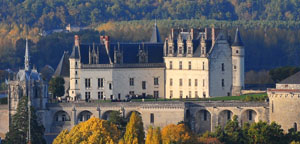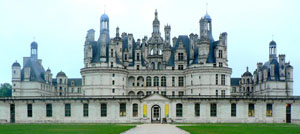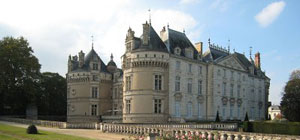Things to do - Châteaux to visit further afield
(Usually these should take between 1 hour and 2 hours to drive to.)

Amboise: This royal château is one of the most beautiful châteaux of the Loire with its landscaped gardens and remarkable panoramas of the Loire River. It was once a favourite with the kings and queens of France. The original 11th century structure was extensively rebuilt in the late 15th century, at first in the late Gothic Flamboyant style and later with Renaissance decorative motifs. In 16th century, Leonardo da Vinci spent the last three years of his life living and working in the Clos Lucé (connected by an underground passageway). The Château du Clos Lucé displays the daily life of Leonardo da Vinci and 40 of his brilliant inventions, including military engineering and flying machines. He is buried in the nearby Chapel of Saint-Hubert.
Amboise: In the heart of a 2 hectare landscaped park, are no fewer than 45 miniature recreations of the finest châteaux in the Val de Loire region. Here children can dress up in period costumes to defend the honour of their heraldic shields in period costume.
Azay le Rideau: This is one of the most famous château of the Loire, built on the foundations of a medieval fortress, on an island in the Indre. This beautiful masterpiece of 16th-century architecture is very elegant, full of period furniture and beautiful tapestries and set in the centre of a romantic park.
Blois: Dominating the Loire River, this royal castle is one of the most prestigious Renaissance buildings in France. It dates back to the 10th century, but became an important residence for French kings during the 16th century. It was also the castle where Joan of Arc was blessed in the 15th century before setting off to defeat the English at Orléans, the turning point in the Hundred Years War. It has some beautifully decorated rooms, featuring the ornate and colourful decoration and furnishings of the period.

Chambord: This is the second most visited château in France and is the largest of all the Loire Valley châteaux. It is a masterpiece of the French Renaissance, built by Francois 1 and contains the largest enclosed forest park in Europe, surrounded by a 32km wall where he used to go hunting.
Chaumont: This medieval château has two massive round guard towers at the entrance of the building. It was owned by Queen Catherine de Medici and then by Diane de Poitiers in the 16th century and then changed hands many times until the 18th century. In the 19th century sumptuous stables were built and an English-style landscaped park created.
Chenonceau: This is the most visited and photographed château of the Loire Valley. In the 16th century, the previous small fortress by the river Cher was replaced by the Renaissance style château leaving only the keep from the original building. It is often known as the "Château des Dames" as throughout its history ladies strongly influenced its design. Diane de Poitiers added the bridge over the Cher as well as the gardens and Catherine de Medici built the gallery and grand ballroom onto the bridge giving the chateau its unique design.
Cheverny: This is among the more famous château in the Loire Valley. It was built in the first part of the 17th Century, in the Louis XIII classical style, with amazing symmetrical architecture of white limestone. It is well known for its magnificent interiors, with its beautiful furniture, tapestries, and ornaments. A large pack of hunting dogs are kept on the grounds and are taken out for hunts twice weekly. It was used in the The Adventures of Tintin books as a model for the fictional "Château de Moulinsart" (Marlinspike Hall).
Loches: This large château which dates back to the 9th century is most famous for its huge square keep. It sits about 500 metres above the River Indre and dominates the medieval town. It was captured and occupied by Henry II of England and his son, Richard the Lionheart during the 12th century and later by King Philippe II in the 13th century. New defensive elements were added over the centuries to complete the citadel, turning it into a huge military fortress. During the French Revolution, much of the building was badly damaged, but much of it was renovated during the early 19th century.

Le Lude: The original fortress was built between the 10th and 11th centuries on the banks of the River Loir in order to defend Anjou first from the Normans and then later from the English during the Hundred Years War. The moat around the château is dry and allows visitors to walk around the foot of the château and also gives access to underground cellars. The beautiful terraced gardens are laid out on several levels and extend along the banks of the River Loir. There is also a walled garden with an orangery and fruit trees, flowers and vegetables.
Plessis-Bourre: This was built on a medieval castle that previously stood here and was one of the most important château in the Loire Valley. It combines a defensive purpose and a luxurious residence, with a wide moat, still operational drawbridge and substantial round towers at each corner. The moats and gardens around the castle are very picturesque and it is one of the most attractive of the Loire castles. Inside, there are many pieces of interesting furniture, tapestries and paintings, from each century since its construction.
Le Plessis-Macé: It still has the remains of the medieval fortress and was built out of black schist stone at the end of the 11th century and later transformed into a magnificent elegant stately residence in the 15th century in flamboyant Gothic style at the beginning of the Renaissance.
Tiffauges: This was origially built in the 12th century and is situated on a rocky crag. It is sometimes called "Bluebeard’s Castle ", due to Gilles de Rais being its most famous resident. It is best known for its remarkable collection of medieval war machines which is one of the best in Europe.
Ussé: This fairy tale château with its romantic, pointed turrets, which was built on a wooded hillside during the 15th century. It has had many owners, one of which was Charles Perrault who is said to have been inspired by the Château when he wrote “Sleeping Beauty”
Valencay: This is one of the most attractive Renaissance castles to be found in the Loire Valley, with turreted towers in two of its corners. The demolished 12th-century castle was replaced in the 16th century by the current building which was completed in the 18th century and the substantial west wing which was added in the 17th century. Inside, its 100 rooms are finely furnished with a magnificent collection of Empire style furniture. The formal French gardens cover about forty hectares, with llamas, peacocks, and other exotic animals in the park.
www.chateau-de-montreuil-bellay.fr - Montreuil Bellay chateau
www.chateau-bauge.com
www.chateaudebreze
www.chateau-brissac.fr/2006/english.htm
www.chateau-amboise.com/en/
www.loire-chateaux.co.uk/
www.chateauxloire.com
www.chateau-de-langeais.com
www.monum.fr - info on the châteaux of Angers and Azay le Rideau
www.lvo.com - Links to châteaux in the Loire
www.chateau-france.com - Links to Loire châteaux
www.chenonceau.com
www.chateauvillandry.com
www.chinon.com
www.tourisme.fr/usse/
http://www.travelfranceonline.com/Loire_Valley/Chateau_d_Usse.html